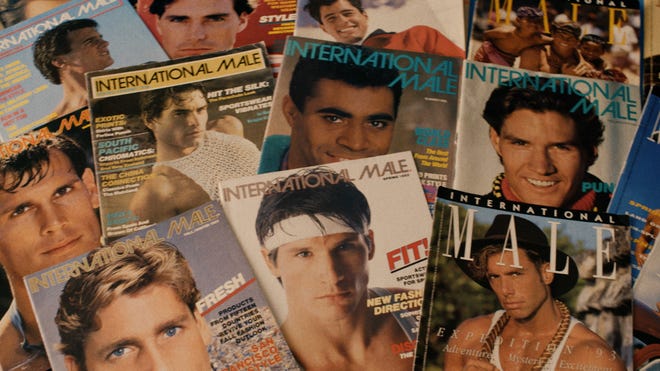At the peak of the 20th century, a mail order clothing company known as International Male would go on to transform men’s fashion and inspire many trends and conversations about masculinity and sexuality that are still relevant today.
A new documentary tells the story of its founder Gene Burkard, the people who worked behind the scenes, the risqué catalogs labeled as “Victoria’s Secret for gay men” and “20 pages of men in their underwear,” the models, and the pitfalls of the company.
Cinema Diverse will screen “All Man: The International Male Story” on Sept.16 and 25.

For a full list of films and screening times, visit https://psculturalcenter.org/filmfest/schedule-at-a-glance. Tickets cost $14.50 for single screenings, $79 for six films and $179 for an all-access pass.
Co-directors Bryan Darling and Jesse Finley Reed said production began on the film before the COVID-19 pandemic began. Burkard, who participated in the documentary, died in 2020 during post-production.
Reed said the idea of doing the documentary was a “happy accident” after discovering a colleague tossed several old International Male catalogs into a recycling bin.
“I saw (the catalogs) and picked them up, held them close to my heart and said ‘Oh my god, International Male!'” Reed said. “It was such a formative thing for me as a young queer person. I brought it to Bryan and said ‘Let’s make a funny little five-minute documentary about this and what it mean to gay men. But as we uncovered the story, it turned into a story about so many other things, too.”
The company was founded in the early ’70s when Burkard, a native of Sheboygan, Wisconsin and U.S. Air Force veteran, was inspired by his travels through Europe exploring his homosexuality and the fashions of European countries. During a trip to Carnaby Street in London, where stores were full of garish and eccentric clothing, he found a male suspensory in a pharmacy window and brought it back to the U.S.
After settling in San Diego, Burkard created a nylon pair of underwear inspired by the male suspensory called the “Jock Sock” that followed the natural lines of men’s anatomy. The Jock Sock was advertised in the LGBTQ magazine The Advocate and Playboy.
‘He just wanted to make things’
The Jock Sock was only the beginning. Men’s clothing at the time was undecorated, dull and identical. Burkard wanted to snap the American man out of the spell of gray suits, blue jeans, briefs and boxers underwear and offer a catalog with more color and variety. Like Hugh Hefner and Playboy, he had a vision of creating a magazine that was also a catalog with the slogan “Freedom for the male.”
International Male was an extraordinary effort for Burkard, who didn’t have any fashion industry experience or business acumen, other than an idea and reading a copy of E. Joseph Cossman’s book, “How I Made $1,000,000 in Mail Order.”
“Gene was not interested in any way whatsoever with the business and how it operated,” Darling said. “He just wanted to make things, put out a catalog and keep doing it. The business grew and needed things like computers and orders, it needed a corporate structure. As it grew more and more, his ability to control and be close to it would not be realistic.”

All the catalog’s copy was written by Burkard in the style of a travel diary to match the fashions inspired by various countries. The models were “masculine guys in not-so-masculine outfits.”
“People who live in coastal areas tend to think in these specific sort of bubbles,” Darling said. “You forget the majority of customers are coming from the rest of the country and live in a very landlocked area. At a time before the internet, when the only way you were going to see other parts of the world, was through documentaries and movies.”
The company wasn’t just selling garments; it was selling a fun-filled, sexy lifestyle. The drawstring pants, blue leather jackets, see-through yarn shirts and underwear appealed to both straight and gay men. About 70% of its customers were women purchasing clothes for their husbands or boyfriends.
International Male opened brick-and-mortar stores and attracted celebrity shoppers Barbra Streisand, Cher, Elton John and Ann Margret. The heavy metal band Whitesnake also made frequent purchases. A former salesperson said in the documentary that he carried a small phone book with 300 customers with detailed information — such as measurements, likes and dislikes and their photos.
Film studios took notice of the brand and purchased clothing for films. One has to wonder, did International Male influence actor Don Johnson’s colorful wardrobe on the ’80s show “Miami Vice?” It’s hard to say, but the company’s poofy white pirate-looking shirt known as the “Poet’s Shirt” appeared in a 1993 episode of “Seinfeld” and is now on display in the Smithsonian’s National Museum of American History in Washington, D.C.
Diversity in the workplace, but not with models
International Male was referred to as “that gay catalog” in some circles, but its staff was a mix of straight and LGBTQ men and women of many ethnicities. Vice President and Head Buyer Gloria Tomita was a Japanese-American single mother when she went to work for Burkard in the ’70s.
In the modeling department, the cast of models was not so diverse. For several years through the ’80s, only four Black models appeared in the catalog. Asian and “darker skin models” were also not included.
While researching this subject further, Darling said the earlier catalogs in the ’70s appear to be more diverse because there wasn’t a strong modeling industry at the time. International Male’s photographer Doug Darnell was known to pick up men off the street for modeling jobs. One of the models used for an early ad was a man whose car broke down and knocked on Burkard’s door.

The explanation provided in the film for a lack of Black models or other people of color is those items wouldn’t sell as much as those modeled by the lighter-skin models.
“I think it’s important for us to be critical today and that comes out of these traditions,” Reed said. “I was watching some John Hughes films recently and was like ‘Was there ever a person of color in these films?’ There wasn’t, and it’s a testament to the time.”
Darnell did feature John Watkins, a white model with a muscular physique and a noticeable hand injury, a result of making a pipe bomb during his teens. In most ads, Watkins’ hand appears to be hidden by pockets or objects, but he said he was self-conscious while modeling swimsuits because there was nowhere to conceal it.
Even though the idea of International Male was promoting comfort in style and body, some of the other models had insecurities about various physical features. Tony Ward said he was timid over his face and spent most of his life building a physique.
The models were well-aware catalogs were being used as erotic material. Former model Robert Gould said, “Straight men did it to Victoria’s Secret and gay men did it to International Male.” Author Frank DeCaro said receiving International Male catalogs in the mail as a gay adult was “on par” to receiving the Sears Christmas catalog as a child.
AIDS took an emotional toll on the staff
While International Male continued to influence men’s fashion and culture throughout the ’80s, the AIDS epidemic was rampant. One of the first staff members to be diagnosed was Darnell and then many more followed. A former phone sales representative said a man called asking when he’d receive a backordered item and didn’t know if he’d be alive to receive it.
The deaths of employees and many customers took an emotional toll on Burkard. In 1987, he sold the company to Hanover Direct.
“He was actively involved with the nonprofit community helping to care for people living with HIV/AIDS, and I think he just felt like, ‘Can I go forward with this?'” Reed said. “This was a time when we didn’t have the amazing medications we have now so people living with HIV could live full lives. He liked being creative, but running the business and dealing with these losses took a toll on him.”
Hanover Direct fired most of the staff and initially struggled to understand International Male’s identity, describing it as having a “gay problem.” But the company managed to mainstream the brand, sending catalogs to 4 million mailboxes in all 50 states and 22 countries. Annual sales eventually went from $12 million to $120 million.
By the mid-’90s, International Male faced competition from young men’s fashion brands such as Abercrombie & Fitch. Fashion houses such as Versace, Calvin Klein, Alexander McQueen and others introduced new styles of underwear and fabrics. Department stores began to devote large spaces to younger demographics. Hanover Direct mailed the last International Male catalog in 2007 and integrated the label into its Undergear line.
There are many discussions in “All Man: The International Male Story” that are front and center today around gender, masculinity and femininity and fashion. Darling and Reed hope the film contributes to the conversation looking back on the legacy of the catalog that started it all.
“(International Male) tried to give permission for men to express themselves, whatever that form of masculinity and sexuality was” Darling said. “It was about providing examples and ways in which you can use clothing, since clothing is the main way we signal a form of expression of ourselves. We’re seeing that now on TikTok, Instagram and other social media where people are using clothing and their bodies as a way to figure out what masculinity and femininity mean to them.”
“We had an interview with (DeCaro) and he said pop culture is often written off as fluff, but it’s so representative of what’s happening in culture,” Reed said. “My hope is that we take people on a journey locating people from this time and place and seeing how this chosen family ended up creating an American success story while dealing with challenges and questions going on in society at that time.”
Brian Blueskye covers arts and entertainment for the Desert Sun. He can be reached at brian.blueskye@desertsun.com or on Twitter at @bblueskye.







